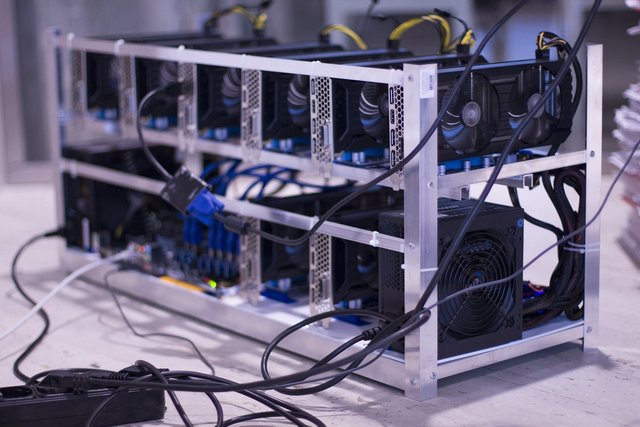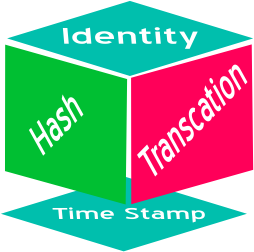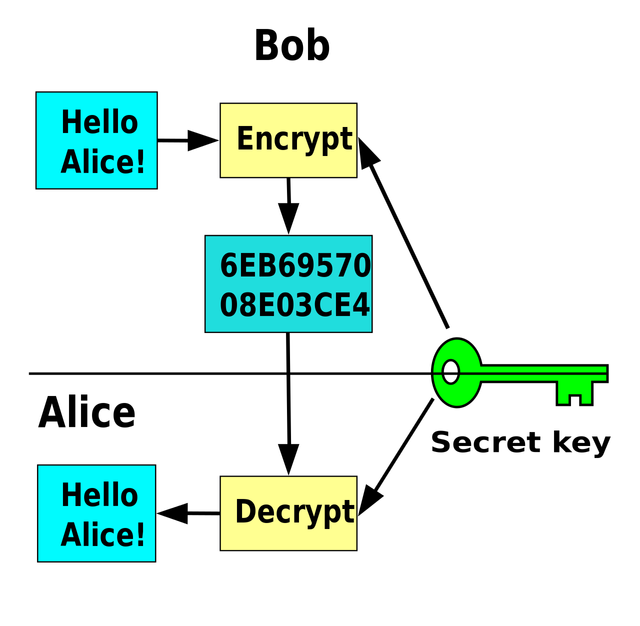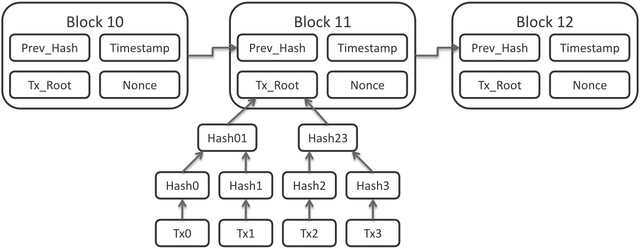Steemit Crypto Academy Contest / S17W1: Steem blockchain Sequencers.

What are the main building blocks of a blockchain and how does the process of sequencing transactions work in a blockchain network?

Blockchain is a decentralized public ledger technology used to record and store transactions online. The records are stored on hardware devices like computers, GPUs, ASICs, etc. These hardware devices, on which the transaction records are maintained, are known as "nodes". The transactions are recorded after verification and validation by the miners and remain publicly available in a non-editable form forever. So, we can say that blockchain is a public database that stores information in the form of blocks connected through a technology known as cryptography. The blocks are connected to each other by a cryptographic code known as a hash and a unique number known as a nonce. So, these connected blocks form a chain, and that is where the name blockchain stems from.
There is no universal classification to discuss the components of a blockchain. However, for the sake of simplicity, let me discuss the components under the following headings: consensus mechanisms, cryptographic techniques, data structure, and network architecture.
Consensus Mechanism
A consensus mechanism of a blockchain depicts the set of rules or protocols of that blockchain, which must be agreed upon by all the participants of the blockchain to securely record the data on the blockchain. These rules are essential to maintain the security and integrity of the blockchain. Examples of different consensus mechanisms are proof of work, proof of stake, delegated proof of stake, practical Byzantine fault tolerance, etc.

Source
Different blockchains follow different consensus algorithms. For example, let's talk about consensus algorithms in the field of cryptocurrency. Let's begin with Bitcoin. We know that Bitcoin is considered the king of cryptocurrencies, and the consensus mechanism it follows is known as proof of work (PoW). According to PoW, the miners who are assigned the job of verifying the transactions require hardware devices like computers with very high computational power to solve complex mathematical puzzles for the verification and validation of a transaction before recording it on the Bitcoin ledger. For each mathematical puzzle, there is a unique solution, and the miner who comes up with the right solution first is entitled to mining rewards. In proof of stake (PoS) consensus algorithm, miners require staking cryptocurrency before being entitled to the validation process, and in delegated proof of stake (DPoS), miners are chosen by the participants of a blockchain for verifying other transactions. The point that I want to emphasize is that each of these consensus algorithms has predefined rules that must be followed by the validators for participating in the transaction validation and verification process and getting rewards.
Cryptographic Techniques
Cryptography is a technique of encoding and decoding data in such a way that only the participants of a particular data or transaction are able to read the coded data. Cryptography techniques lie at the heart of blockchain to ensure its security, transparency, trustworthiness, and non-repudiation of transactions performed. Cryptography involves hash functions, digital signatures, and Merkle trees to ensure data storage and security. A hash function is a technique to convert input data into a cryptographic code known as a hash value, which is a form of encrypted message that can be decrypted by digital signatures composed of private and public keys. The record of transactions forms a hypothetical tree-like structure in which each transaction is connected to the previous one through a cryptographic hash of the previous transaction.
Data Structures
The data structure of a blockchain represents how data is stored on a blockchain. Having mentioned earlier that data is stored in blocks connected to each other to form chains, hence the name blockchain. Each block is composed of a transaction hash, transaction root, a unique number known as a nonce, and a timestamp. Such a complex structure of each block is maintained through cryptographic techniques to ensure the security and integrity of the blockchain. Similarly, other data structures adopted by blockchains include directed acyclic graphs (DAGs).
Network Type or Architecture
Network architecture refers to the interaction between different nodes within a network and therefore determines the type of network. We usually refer to blockchain as decentralized, which reflects that the mode of communication between the nodes is peer-to-peer without the involvement of any centralized authority. We have centralized blockchains and hybrid blockchains too where , as some element of censorship is present, and the mode of communication involves a third party in between, raising concerns about the security, transparency, and non-editability of the network.
Process of Sequencing Transactions:
Sequencing refers to the series of events that take place on a network from the time of the execution of a transaction to the successful completion of the transaction. Understanding the sequencing helps in understanding the working of a network. Let me mention the steps of sequencing:
Transaction Submission: Submission of a transaction is the fastest step to begin with. A transaction does not necessarily mean any monetary exchange; it can be the exchange of data, execution of a small contract, or the commonly understood monetary transaction. So, whatever the transaction, it begins with a sender submitting the transaction on the network.
Validation: The process of validation is carried out by nodes by verifying various parameters of a transaction, like digital signatures, adherence to the protocol, submission of accurate data like the requisite amount of funds compared to the balance, etc. Once the data is found to adhere to the network protocol, it's considered valid for further processing.
Mempool of Transactions: The mempool is the collection of validated transactions before storage of the transactions in the form of blocks. So, it is a temporary waiting area for transactions until a miner or validator picks them up for storage into a block.
Block Formation: The transactions are picked from the mempool by the validators or miners after successful completion of the consensus algorithm and aggregated in the form of blocks. The consensus algorithm varies from network to network; for example, in the case of Bitcoin, miners must solve complex mathematical puzzles through the computational power of computers to find the unique solution for the validation of transactions and then store them in the form of a block.
Block Propagation: Once data is stored in a block after verification of the consensus mechanism, the blocks are propagated to other nodes of the network so that all nodes update a copy of the verified script for distribution across the ledger, establishing transparency.
Completion of Transaction: Once the transaction is recorded on all the nodes, it is considered final and is immutable and irreversible thereafter. The transaction is publicly accessible to all for the sake of transparency but is non-editable to ensure security.

Describe how the Steem blockchain sequencer works, highlighting its specific characteristics and its role in consensus. Illustrate a graphical diagram to explain how it works.

The workings of the Steem blockchain sequence are similar to any other blockchain, and the basic steps remain the same as explained above:
Transaction Submission: Users of the network submit their transactions. These transactions can be anything like posting comments, making transfers, downloading content, or sending tokens to others.
Transaction Pool: The submitted transactions are added to the transaction pool, awaiting verification and validation by the witnesses before being added to any block.
Block Creation: Blocks are created by witnesses chosen by community participants through a voting process. These witnesses select transactions from the pool after verifying them and add them to the block. The selection of transactions from the pool depends on various factors like transaction fee, network congestion, transaction size, etc. Witnesses carry out protocol checks to ensure the adherence of transactions to community guidelines before adding them to the block.
Block Propagation: The selected block, after verification, is propagated to all other nodes in the network so that all participants are aware of the state of the blockchain.
Block Confirmation: Other nodes receiving the propagated block also need to confirm the correctness of the block data for the successful completion of the consensus process.
Block Extension: The confirmed blocks are added to the existing blockchain, forming a chain in which every subsequent block is linked to the previous block through a transaction hash. The confirmed blocks in chains form a reversible and immutable record of transactions.
+-------------------------------------------------------+
Transaction Submission
+-----------------------------------------------------+
Transaction Pool
+-------------------------------------------------------+
Witness Selection
+-------------------------------------------------------+
Data Verification
+-----------------------------------------------------+
Block Creation
+------------------------------------------------------+
Block Validation
+---------------------------------------------------+
Consensus Mechanism
+---------------------------------------------------+
Block Propagation
+----------------------------------------------------+
Confirmation
+--------------------------------------------------+
Chain Extension
+--------------------------------------------------+
Transaction Finality
+--------------------------------------------------+

What are the different consensus algorithms used in blockchains, and how do they influence the transaction sequencing process?

There are several consensus algorithms adopted by different blockchain networks for various reasons. Let me mention a few important consensus algorithms:
- Proof of Work (PoW)
- Proof of Stake (PoS)
- Delegated Proof of Stake (DPoS)
- Practical Byzantine Fault Tolerance (PBFT)
- Proof of Authority (PoA)
- Directed Acyclic Graph (DAG)-based algorithms like Hashgraph and IOTA's Tangle.
Now, let me briefly mention these algorithms in the context of sequencing transactions:
Proof of Work (PoW): This consensus algorithm requires miners to solve complex mathematical puzzles using the high computational power of the nodes before adding data from the transaction pool to the block. The miner who solves the puzzle first is entitled to the block rewards from the minted cryptocurrency. Therefore, we can say that the proof of work consensus algorithm is a rate-limiting step in the sequencing of transactions on the network that follows this algorithm. This mechanism is resource-intensive and has low transaction throughput.
Proof of Stake (PoS): This consensus algorithm was introduced to tackle the shortcomings of the proof of work algorithm, such as energy costs, centralization of mining power, and scalability issues. In this mechanism, validators stake their funds as collateral for carrying out the task of validating transactions. The sequencing of transactions is determined by the order in which transactions are presented to the network.
Delegated Proof of Stake (DPoS): In this consensus algorithm, the validators are chosen by the participants of the network. It enhances scalability and security further, as validators are routinely changed based on their activities and the voting of the participants. The sequencing in this consensus algorithm depends upon the activity of the validators.
Practical Byzantine Fault Tolerance (PBFT): This consensus mechanism is adopted by some permissioned blockchains, in which leaders choose the transactions for validation by the network nodes. So, the sequencing depends upon the leader's order and validation by a subset of nodes. This consensus belief has high transaction throughput and security, as only known leaders are allowed to participate and start the sequencing process.

Explain the role of different types of nodes (like full nodes, light nodes, etc.) in the process of sequencing transactions within a blockchain.

Nodes are the building blocks of a blockchain's infrastructure. These are hardware devices that store the software of blockchain necessary for maintaining the integrity of the blockchain. Each blockchain consists of several types of nodes, some of which are crucial for sequencing transactions:
Full Node: Full nodes download and store a complete copy of the blockchain ledger, making them the most important component. They independently verify transactions and data, confirming consensus and other network protocols. Full nodes add verified transactions to the mempool and propagate mined blocks to the network.
Light Node: Light nodes only store essential transaction information, lacking a complete copy of the blockchain ledger. They rely on full nodes for transaction verification and validation. Light nodes receive transactions, broadcast them to the network, and await confirmation from full nodes before sequencing their own transactions.
Miner Nodes: Miner nodes play a vital role in generating new blocks and then adding transactions from the mempool. After creating a block, miner nodes select transactions based on criteria like transaction fees and timing, ensuring smooth transaction sequencing. Without miner nodes, verified transactions would remain in the mempool, disrupting the sequencing process.
Other node types like master nodes, authority nodes, and supernodes have limited functions and are specific to certain blockchains, so their discussion isn't necessary here.

Discuss the importance of decentralization and governance in the context of the Steem blockchain. How does Steem's governance structure affect transaction sequencing and network security? Give a practical example that explains operation

"Decentralization and governance of any blockchain, including the Steam network, are key components to establishing the security and integrity of a blockchain. Decentralization ensures equitable distribution of power among all the components of the network, whereas governance ensures fair decision-making rights by the expense and not by any particular agency.
Decentralization on the Steam blogging platform is ensured through its consensus mechanism known as Delegated Proof of Stake (DPoS). According to this mechanism, stakeholders of the network choose their representatives or witnesses who are entitled to validate the transactions and mine the blocks. This mechanism ensures that there is no centralization of power and is resource-effective, unlike the Proof of Work algorithm that Steam initially followed.
Governance on the Steam blockchain is through the Steem Proposal System (SPS) and Steem DAO. According to the Steem Proposal System, stakeholders are entitled to propose their initiatives or suggestions for improving the network. These proposals are reviewed and voted on by the community, and the approved proposals receive funds from the team treasury for their final execution. Similarly, Steem decentralized autonomous organizations take part in matters like resource education for upgrades independently.
So, the decentralization model and governance model executed through elected witnesses and SPS/DAO ensure an egalitarian and transparent network, which is secure.
Now, let's look at the impact of Steem governance on sequencing and security:
The transaction sequence on the Steam blockchain is determined by the order in which the elected witnesses add the transactions to the blocks. The usual protocol that's followed is 'first come, first add,' which means that the transaction that arrives first to the network is added first to the block after verification. However, witnesses have the right to choose the transaction, and they can base their choice on other factors like network fee.
The on-chain voting mechanism for the election of witnesses and the limited period to which they are entitled to these rights, besides the stated amount of Steem, ensure the fair and transparent working of the witnesses and safeguard the network against any malicious attempt of forging the transactions. So, this decentralization and rotatory model of the election of witnesses ensure that there is no concentration of power within a few hands and no one is permanently entitled to any post.
Practical Example:
Let's presume that I, as a thick holder of the Steam blogger, notice any glitch in the smart contract functionality of the Steam blockchain, which is likely to compromise the defense of the users on the blockchain. As a stakeholder, I consider it my responsibility to ensure the security of my funds as well as the funds of the other users. So, I can propose a security audit with appropriate reasons and a detailed project report. The community, after reviewing the proposal, would look at the cost-benefit analysis of the proposal and vote to accept or reject it.
Once the proposal is accepted, funds will be allocated from the treasury of Steam, along with all the details of the process of carrying out the audit, audit team, time, and the results of the audit. The community participants have the right to know the measures taken and the improvements achieved in the direction of the proposed goals. That's how the decentralization model acts to ensure the integrity of the network, including security, transparency, and trustworthiness.




Thank you, friend!


I'm @steem.history, who is steem witness.
Thank you for witnessvoting for me.
please click it!
(Go to https://steemit.com/~witnesses and type fbslo at the bottom of the page)
The weight is reduced because of the lack of Voting Power. If you vote for me as a witness, you can get my little vote.
Thanks
Your steemit article supplies a thorough introduction of blockchain modern technology describing its decentralized nature and also the important duty of nodes and also miners in keeping its honesty. The breakdown of consensus mechanisms, cryptographic methods information framework as well as network style uses a clear understanding of the elaborate functions of blockchain. It's interesting to see exactly how numerous consensus mechanisms, such as evidence of job as well as evidence of risk drive various blockchain networks each with its very own collection of regulations and also awards for validators. Recognizing these parts is vital for understanding the capacity as well as convenience of blockchain innovation throughout various applications.
Thank you for your thoughtful comment.
I'm glad you found the article helpful in understanding the intricacies of blockchain technology. It's indeed fascinating to see how various consensus mechanisms drive different blockchain networks, each with its own unique rules and incentives for validators.
Thanks
You are most welcome friend. It was a pleasure to read your article.
Greetings friend,
Your article explains blockchain technology in detail, covering its decentralized nature, the roles of nodes and miners, and the different consensus mechanisms. Understanding these components is crucial for realizing the potential of blockchain technology.
You are right. They represent the fundamental and core concepts of the blockchain.
Thank you.
TEAM 5
Congratulations! Your post has been upvoted through steemcurator08.Thanks .
Greetings my friend @drqamu! Your detailed breakdown of blockchain technology is impressive. Explaining consensus mechanisms and governance in a clear manner enhances understanding. Keep up the excellent work! All the best in the contest, success for you! 👍
Thank you so much for your kind words! I'm glad you found the breakdown helpful. Understanding blockchain technology can be complex, so I strive to make it as clear as possible.
Your support means a lot to me. I'll keep pushing forward!
My pleasure 😊😊😊😊
You man it obvious that you did so hard and you feel your content with high quality data and knowledge to make it outstanding and now I really appreciate because just meet me a little bit smarter after.
Thanks for sharing such quality article, wishing you the best please keep it up. Kindly drop a comment to my post using the link https://steemit.com/hive-108451/@starrchris/sec-s17-w1-or-or-steem-blockchain-sequencers
Thanks for your kind words.
Hello dear
This is Great article You explained the structure and layout of the Steem blockchain in a very simple and clear way. Your graphical diagram made my understanding of the working of the Steem blockchain even stronger. Best wishes for you.
Thank you for your kind feedback.
Your most welcome dear friend